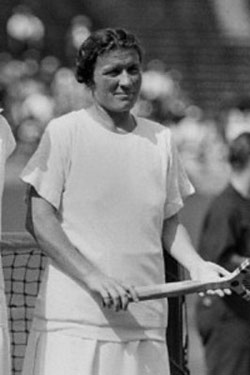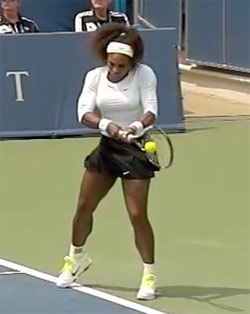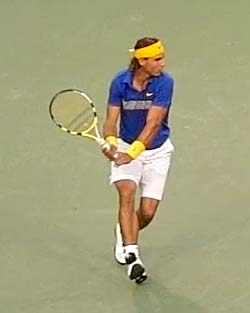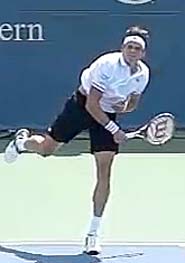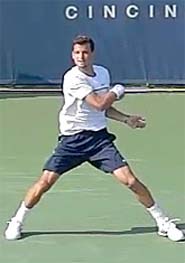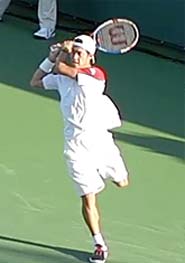|
TennisOne Lessons Will Serena or Novak Capture the Holy Grail of Tennis? Paul Fein
“Do you think Margaret Court wonders if Serena will catch her?” mused ESPN analyst Mary Joe Fernandez during the Australian Open semifinals. Court’s all-time record of 24 Grand Slam singles titles seemed safe with 33-year-old Serena Williams far behind at 18. But who knows?
Elizabeth “Bunny” Ryan often declared she would rather die than see her record of 19 Wimbledon titles broken. On the day before Billie Jean King won her record 20th Wimbledon title in 1979, Ryan died from a heart attack at age 87. Oh, how champions cherish their records and the immortality they confer. Think of Wilt “The Stilt” Chamberlain’s 100 points in an NBA game, Joe DiMaggio’s 56-game hitting streak in baseball, and hockey legend Wayne Gretzky’s nine Hart Trophies (MVP). Golf buffs treasure Byron Nelson’s 1945 record of winning 11 straight PGA tournaments. And how about track superstar Edwin Moses: unbeaten in the 400-meter hurdles for nine years, nine months, and nine days! Easy to remember; impossible to duplicate. But records are also made to be broken, and record chasers covet them. Serena will have to wait at least until 2016 to threaten Court’s record. This year, though, the Superwoman who grew up playing with her sister Venus on the dilapidated courts of crime-ridden Compton, California, can focus the steely stare she uses to intimidate opponents on the Holy Grail of Tennis: the Grand Slam. “Winning the Grand Slam in tennis is as great an achievement as you can have in any sport,” declared Andre Agassi, who grabbed all four majors in his career but never in the same year. Don Budge, a pretty modest guy, was so proud of being the first Grand Slammer in 1938 his car had vanity plates that read “G SLAM.” Not since Steffi Graf won all four major tournaments in 1988 to capture the last singles Grand Slam has the prospect of a top player, or even two, achieving this rare feat looked so likely. Serena’s quest for major titles stalled in 2014 until she steamrolled the US Open field, losing no more three games in any set. “Getting to 18 took a lot out of me. But once I did that, a whole burden was taken off of me,” confided Serena before the Australian Open final. “Now I’m having a lot of fun.” After she defeated No. 2 Maria Sharapova 6-3, 7-6 in the rip-roaring final, Serena left no doubt she was thinking about Graf’s Open Era record of 22 majors. “I would love to get to 22,” she said. I mean, 19 was very difficult to get to. Took me 33 years to get here, so . . . I would love to get there. I definitely think I am ready to go for the record, and I’m not afraid.” Serena afraid? Au contraire. She strikes fear in opponents, particularly after her blazing 24-1 match record this year.
The next major, the French Open, should prove Serena’s toughest test, though. She’s raised the Coupe Suzanne Lenglen trophy only twice in 13 tries, although her recent 2013 title will boost her confidence. Her groundstroke power and rocket serves, which produced 18 aces and peaked at 203 kph (126 mph) against Sharapova, are blunted somewhat on Roland Garros red clay, but she has several things going for her. There hasn’t been a great female clay-court player since the retired Justine Henin, who eliminated Serena in 2003 and 2007. And Serena has whipped No. 2 Sharapova, the 2012 and 2014 French titlist, 16 straight times. It also doesn’t hurt that she has an apartment in Paris and a French coach, Patrick Mouratoglou, whom she adores. On his protégée, Mouratoglou explained, “She has something she was born with and it’s her character. She refuses to lose. And when she refuses to lose, she finds solutions that are incredible.” If battle-tested veterans like Sharapova and two-time major winners Victoria Azarenka (3-15 against Serena) and Petra Kvitova (1-5) can’t pose unsolvable problems for Serena, The New Generation might. Baseline blaster Madison Keys, 20, pushed Serena for one set in the Australian semis, and Serena predicted, “I think she can be the best in the world.” Eugenie Bouchard, 21, Garbiñe Muguruza, 21, and French Open runner-up Simona Halep, 23, all have defeated Serena decisively in the past eight months. If Serena, who has won 45 of her last 48 matches on clay, takes the second leg of the Grand Slam in Paris, she’ll benefit from another stroke of good fortune. For the first time, three weeks separate the French Open and Wimbledon. That means she has an extra week to rest and recover from any injuries as well as three weeks to prepare on grass at tune-up tournaments. Serena is more dedicated than she was in her 20s when she was distracted by acting, fashion design, and other extracurricular activities, even though during the second week of the Australian Open, she did film a television commercial to raise awareness about motor neuron disease (MND). Unlike Roger Federer, who is clearly declining at 33, Serena seems unstoppable now, even when ailing. Force of Nature Serena suffered from a severe cold during the unseasonably cool Melbourne fortnight and coughed during the final. With the score 3-2, 30-all inside the Rod Laver Arena, a drizzle stopped play for 12 minutes as the roof was closed. When Serena left the court, she threw up during a match for the first time in her 17-year pro career. After she returned and without any warm-up, Serena, as only she can, blasted an ace, a forehand winner and then broke Sharapova’s serve at love. After winning big points, Serena fist-pumped and shouted “C’mon!” so often in the fiercely fought second set of her 6-3, 7-6 victory that ESPN analyst and former great Chris Evert remarked, “We never yelled ‘C’mon!’ in our day.” But her day had never witnessed the force of nature that is Serena Williams either. At her overpowering best, Serena indisputably plays the highest level of tennis in women’s tennis history. Yet she hasn’t pulled off a Grand Slam, unlike legends Maureen Connolly (1953), Court (1970), and Graf (1988). “Is it possible Serena Williams, in her 30s, could win a calendar-year Grand Slam? Why not!” said former doubles star Pam Shriver. Lindsay Davenport, a three-time major winner, agreed, “I get the feeling she’ll add a lot more major titles to her resume. Serena is the best athlete who has ever played this sport.” Like Serena, Novak Djokovic grew up in an unconventional environment in war-ravaged Serbia, a country with no tennis tradition. While Serena and her older sister Venus were told by their father-coach Richard to drop fast when bullets were flying in the 1980s and early 1990s, young Djokovic endured NATO bombing in shelters near his Belgrade home in 1999. “We remember all these things and we will never forget, because it’s just very strong inside of you and very deep inside of you,” Djokovic told The New York Times in 2010. “They’re traumatic experiences and so definitely you do have bad memories about it. We heard the alarm noise about planes coming to bomb us every single day a minimum of three times for two and a half months, huge noise in the city all the time, all the time. So in my case, when I hear a big noise even now, I get a little traumatized.”
That background helps explain his mental toughness as well as his burning ambition to bring tennis glory not only to himself and his devoted family but to his controversial homeland. His marriage to longtime girlfriend Jelena Restic last July and the birth of his son, Stefan, last October have also meant the world to him. “It has deeper meaning, there’s more intrinsic value to my life now,” Djokovic said after winning his fifth Australian title by stopping Andy Murray 7-6, 6-7, 6-3, 6-0. “I play to win big titles and for the people around me. Getting married and becoming a father gave me a new energy.” The Nadal Obstacle Djokovic, 27, will need every bit of that energy to dethrone clay-court king Nadal at the French Open, the only major he has never won, to capture the Grand Slam in 2015. Nadal’s nine Roland Garros titles are an astounding tennis record that likely will never be broken. The muscular Spaniard, 28, prevailed all six times they met on the terre battue, though Djokovic nearly pulled off an upset in their 6-4, 3-6, 6-1, 6-7, 9-7 epic two years ago. When asked why this title had eluded him, Djokovic said, “It’s a grand slam [event], playing best of five [sets] on the slowest surface that is physically demanding, and that’s something that makes it more difficult.” Translation: Sooner or later, Nadal’s relentless, grinding game breaks down opponents physically, mentally, or technically.
Even so, Nadal, plagued by an assortment of back, knee, and wrist injuries during 2014, may finally prove beatable. Lacking match play, he performed poorly in his Australian Open quarterfinal loss to Tomas Berdych. Importantly, Djokovic has beaten Nadal 19 times overall (against 23 losses) in their rivalry, including four times in the past four years on clay. If Djokovic, runner-up in 2012 and 2014, can capture Roland Garros, the remaining two majors are clearly winnable. He’s the defending champion at Wimbledon, where he won a five-set thriller final last year against Federer, now in the late twilight of his storied career. Similarly, Djokovic would be the favorite at the US Open, where he’s taken the title once and been runner-up on four occasions. “I’ve come close before,” an optimistic Djokovic told Tennis Channel, referring to his spectacular 2011 campaign when he won three majors but was derailed by Federer in the Roland Garros semifinals. “It’s possible, but it’s probably the ultimate challenge you can have in sport.” But what about all those Young Guns much-touted to overthrow the Big Four—Djokovic, Nadal, Federer, and Murray—for the past five years? They’re actually not that young anymore, and their guns aren’t that devastating. Kei Nishikori, 25, did reach the 2014 US Open final but was overpowered by Marin Cilic, and he suffered the same fate against Stan Wawrinka at Melbourne. Grigor Dimitrov, 24, dubbed “Baby Fed” for his immense talent and similar style to Federer’s, is hampered by a weak one-handed backhand and has reached only one major semifinal. Milos Raonic, 24, has ascended to No. 4, but a phenomenal serve hasn’t offset his lack of speed and mediocre backhand, net game, and serve returns. While Djokovic doesn’t underestimate these arrivistes, he isn’t overly impressed either. “The gap is narrowed, but it’s still a long way for the new wave of tennis stars with the likes of Raonic, Dimitrov, and Nishikori to make that step and break the domination of the top four guys,” he said. “They are close and they are challenging and they are knocking on the door, but still if you see the winners of the Grand Slams, it is still the top four guys. Last year we had [veterans] Wawrinka and Cilic [winning majors] which are two new names, but the young players still have to work to get there.”
Darren Cahill, the astute ESPN analyst, likes Djokovic’s chances this year to join Budge and Rod Laver (1962 and 1969) as the only male Grand Slammers. “Novak is playing as good tennis as he’s ever played,” said Cahill. “He’s capable of winning another two [majors] this year, maybe three, if he breaks through at the French Open.” Djokovic, even more than Serena, boasts a near-perfect game, with not a technical weakness. That accounts in large part for his high-level consistency during matches, tournaments, and seasons. Not surprisingly, the Serb has reached the semi-finals or final in 16 of his last 17 majors and won the last three ATP Finals. Like Serena’s, his momentum seems irresistible, having grabbed every Masters 1000 tournament—Indian Wells, Miami, and Monte Carlo—this year. One can criticize Djokovic’s net positioning, not putting away enough overheads, or occasional shot-selection lapse—such as a dubious drop shot on big points against speedy players. But these are minor cavils. Superbly fit, fast, and flexible, while possessing the firepower of men taller and heavier, the 6’2”, 174-pound Djokovic combines those physical qualities with the mentality of a champion. Two lines in Kipling’s immortal poem “IF” encapsulate the revealing Australian Open final:
After Djokovic and Murray battled evenly for two and a half sets, the petulant, distracted Murray, barking that Djokovic was feigning injuries, collapsed. The disciplined, poised Djokovic, despite an injured thumb and ankle and feeling ill for 20 minutes, sprinted to the finish line. A Grand Slam tournament, especially the high-pressure final, is an often brutal but fair test of character. Djokovic passed this one with flying colors. Three more majors to go. He is a man in full now. His quest for the Holy Grail will succeed.
Your comments are welcome. Let us know what you think about Paul Fein's article by emailing us here at TennisOne.
Paul Fein Paul Fein has received more than 30 writing awards and authored three books, Tennis Confidential: Today’s Greatest Players, Matches, and Controversies, You Can Quote Me on That: Greatest Tennis Quips, Insights, and Zingers, and Tennis Confidential II: More of Today’s Greatest Players, Matches, and Controversies. Fein is also a USPTA-certified teaching pro and coach with a Pro-1 rating, former director of the Springfield (Mass.) Satellite Tournament, a former top 10-ranked men’s open New England tournament player, and currently a No. 1-ranked Super Senior player in New England. |
